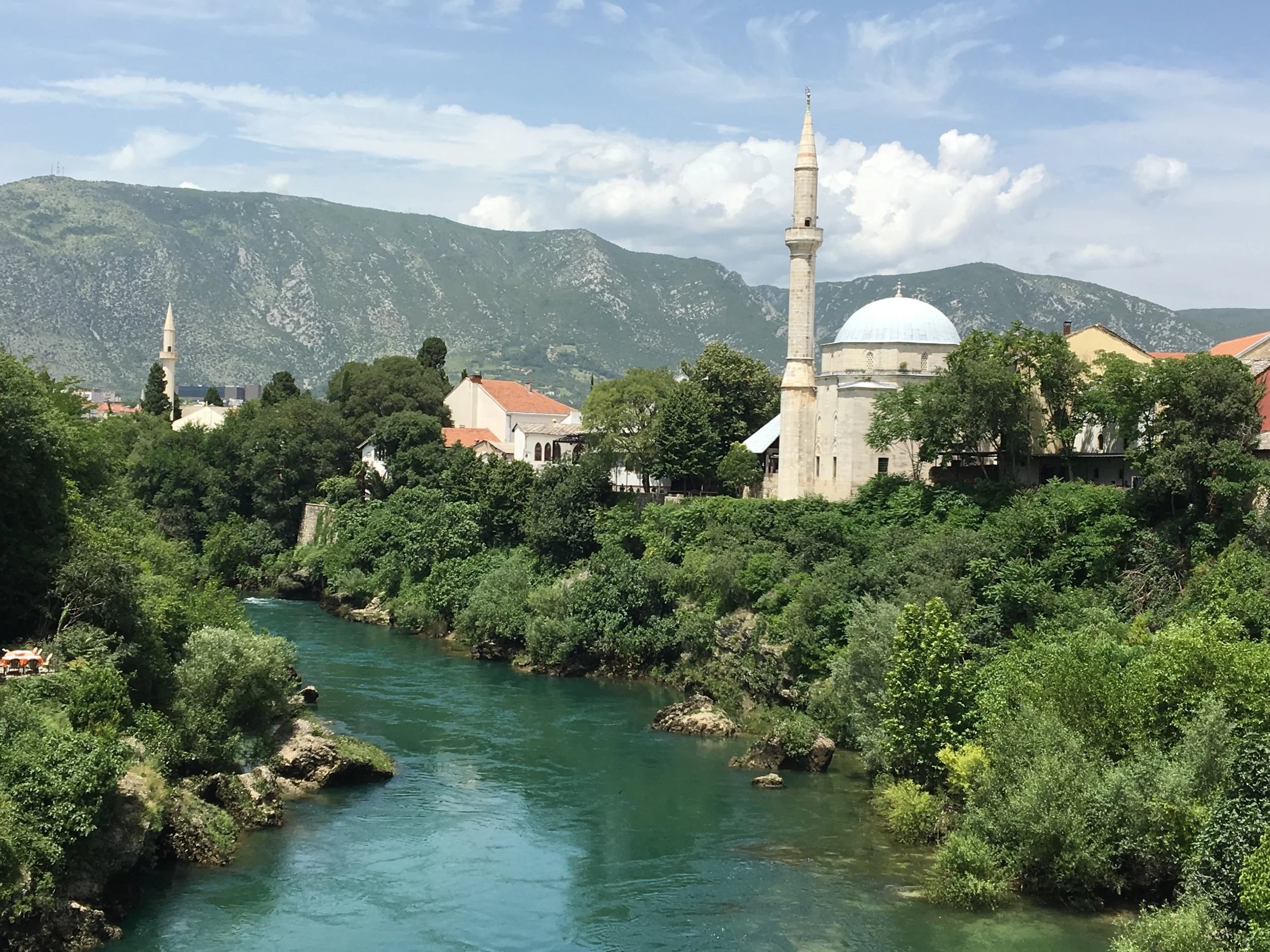Bosnia
Beautiful Mostar, Bosnia
Officially called Bosnia and Herzogovina since the split of Yugoslavia into six (now seven) new countries, Bosnia is an easy day trip from Croatia but feels like a different world. While Croatia is inhabited mainly by Catholic Croats, and Serbia by Serbian Orthodox, Bosnia is populated by Catholics, Muslims and Orthodox citizens. While I wish we had time to visit Sarajevo, we loved our day in Mostar, Bosnia.
Although it is possible to rent a car in Dubrovnik and drive yourself two hours to Mostar, or join a tour bus, for 220 Euros we hired Pepo Klaic to take us to Mostar. Pepo fought in the 1991 war, defending his hometown of Dubrovnik during the eight-month siege of the city. Pepo picked us up from the Hilton Dubrovnik (click here to read about our time in Croatia) at 9:30 am, and drove my husband, two kids and me up into the hills of Dubrovnik where the fighting occurred in 1991-92. Pepo described his experience to us - how he didn't want to fight and his mother begged him to avoid it. How it didn't seem real that his city was being attacked. How he and others found old rifles in their basements and based themselves in the old fort in the hills above the city. How he went without food, water or sleep. How he carried wounded comrades down the hill into the city for medical care. Pepo showed us bullet holes people left unrepaired in their garage doors as reminders of the horrific months. And what stuck with my children most was Pepo's description of how the opposing side's soldiers waited for women to line up for water in the mornings so that they could shoot them.
Homegrown treats for sale in Pocitelj, Bosnia
After Pepo patiently and honestly answered our and my children's dozens of questions, Pepo drove us into nearly landlocked Bosnia, stopping in a village called Pocitelj. In Pocitelj, we walked past old women selling paper cups of cherries, apricots, pears, peaches, figs and nuts, promising to buy some on our way back. We followed the old stone road up to the entrance to the mosque, where a welcoming young man asked for a couple of Euros to enter. My daughter, who had just completed a unit on world religions at school, loved seeing the small mosque and recognizing things she had learned about Islam. After fulfilling our promise to buy some cherries, we climbed back into the car for the final stretch to Mostar.
Mostar's famous bridge, rebuilt after damaged in the 1991 war by UNESCO
Entering into Mostar, Pepo explained how the Croats lived on one side of the front line and the Bosnian Muslims on the other. He showed us building after building, damaged by the war. Pepo explained how the aftermath of the war and the diverse religions affect the current social fabric of the nation. After parking the car, Pepo walked us into the touristy pedestrian center, which spans two sides of the spectacularly green river running through the beautiful town. He showed us the famous bridge that played such a prominent role in the war, rebuilt in its original style by UNESCO and now home to the divers who plunge to the waters below in exchange for a few Euros from tourists. As we stood by the riverside in the blazing heat, we could feel how the frigid mountain-fed river cooled the air around us. As we enjoyed the natural air-conditioning, the Muslim call to prayer began to play over a mosque's loudspeakers. I recalled the first time I had heard the call to prayer, waking me up in the early morning in Istanbul when I was 24 years old. I remembered how I had smiled in my sleepy state, excited to be someplace so different from my own world. As I watched the faces of my nine- and twelve-year-old children, they seemed less moved, but still interested.
Bosnian specialties at Restoran Babilon
Pepo left us to have lunch and explore the town on our own. We had delicious local specialties at Restoran Babilon on the river, including stuffed peppers and tomatoes, grilled meat and rice. Sit on the riverside terrace for a spectacular view. The restaurant is touristy, but we thought the food was tasty. We strolled the outdoor markets, where my daughter bargained for a backpack with a kind salesperson. Seeking an escape from the heat, we entered the cool "Turkish Bath Museum"- not really worth it for a learning experience, but the white marble interior gave us a reprieve from the heat and we enjoyed chatting with the local young man who asked us "Trump or Clinton?" giving us the thumbs up when we answered correctly. Continuing past the markets up the river, we stopped in another mosque to take a look, and moved on to an old Turkish house that is now a small museum. Each site took about five minutes to walk to, and five minutes to explore, and honestly with two children, the blistering heat, and our general low-to-medium tolerance for museums, that was perfect.
Mostar, Bosnia
Wandering the outdoor markets in Mostar, Bosnia
My daughter loved Bosnia. She said she felt like she was in "the Middle East or India". It felt exotic - different from any European country she has visited. We loved the spectacular scenery, learning about the war history and experiencing bits of different cultures - Turkish, Bosnian Muslim, Croat.
At 4:00 pm, Pepo met us to drive us back to Dubrovnik, telling us more about the region and his life experiences. After all that he endured, Pepo amazed us with his positive and unbiased attitude. He is not bitter. He is not angry. He does not hate or pass on hatred to his son. Pepo is a person who cares about other people, regardless of nationality or religion. On our day with Pepo, we not only learned about the war, we also witnessed how a veteran moves on with his life - how his identity is not just "veteran" or "Croat", but "human being".
Pepo can be reached at: pepoklaic@yahoo.com and 385-98-4273-01.







